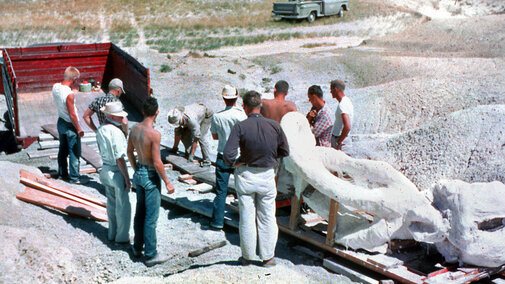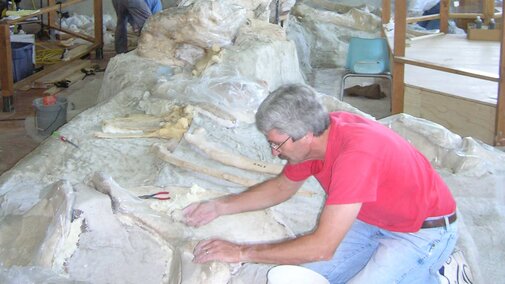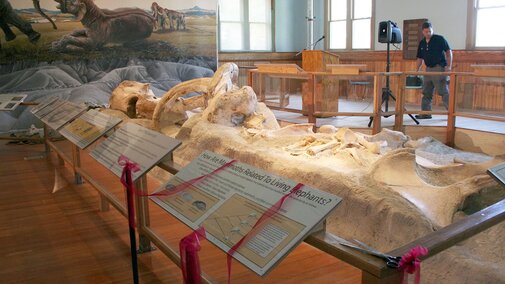The Battle
More than 10,000 years ago, a pair of "testosterone-crazed" bull mammoths crossed paths on the ice age high plains in what would one day be western Nebraska.
Nearly equal in size and around 40 years old each, the two Columbian mammoths -- one with a snapped tusk on the left, the other with a break on the right -- battled for mating rights. However, fate thwarted desire.
With the broken tusks allowing each to jockey in close, the titans locked together and never separated. Eventually -- after hours of exhaustive pushing or moments after a decisive twist -- one fell, dragging the other to the ground, and each to their death in the Little Badlands north of Crawford.
_________________________________________________________________________________________________________________________________________________
Discovery & Recovery
In 1962 Mike Voorhies (former UNSM Vertebrate Paleontology Curator) was a 21-year-old senior at the University of Nebraska-Lincoln and leading a UNSM crew searching for fossils in the badlands. When the weather was poor and limited field work, Voorhies helped with exhibits at Trailside Museum. One day, two men from the area brought a fossil wrapped in a feed sack into the museum.
"That bone was quite a surprise," said Voorhies. "We knew right away it was an elephant. They are pretty scarce in that part of the state, so we went out to look and scratch around a bit."
Voorhies noticed a large amount of bone and received permission from landowner Tom Moody to start a dig. Moody helped, removing the uppermost layers of soil with his backhoe. Voorhies and other members of the crew scraped away the remainder of sediment and eventually discovered two skulls.
"When we started to uncover the mammoth, the point of the tusk was headed the wrong way," Voorhies said. "We thought that when the elephant died that it fell forward and broke a tusk and it pointed back toward him."
The discovery of a second skull jolted Voorhies.
"It was probably the most exciting fossil I've ever seen," Voorhies recalled. "Someone with a lot of experience would have known right away. We were basically teenagers without a lot of digging experience, flying blind."
However, the young paleontologists realized they found an international treasure: two bull mammoths, dueling titans, locked in combat to the death. "We don't know exactly why they fell down, but it seems almost as if fate conspired against these two," Voorhies said. ""They really suffered some bad luck."
Covering the bones in shellac then protecting them in layers of paper, burlap and plaster, the team prepared to transfer the fossils to the museum Research Collections. The agreement with Moody allowed the skulls to be moved to Lincoln and required the mounting of one of the skeletons for display at the Trailside Museum. The skulls and remaining skeleton were to stay in Lincoln for study until a newly renovated, secure exhibit space could be created at Trailside Museum.
_____________________________________________________________________________________________________________________________________________________
Return to the Panhandle
For 43 years, the fossils remained in the museum Research Collections. But in 2006, with improvements in exhibit technologies, and with support from the State of Nebraska, local residents (Crawford grade school children raised $2,000 with a Mammoth Walk), and Friends of the Prehistoric Prairies Discovery Center, the dueling mammoths returned to Crawford.
Paleontologists from UNSM worked diligently to prepare the fossils for transport. They were encased in plaster and burlap sacks to make the specimens immovable. The biggest concern was whether the fragile tusks would be damaged in the move. Extra care was taken during transport. Upon arrival, the large truck carrying the fossils had to be lifted 30 inches off the ground in order to be level with Trailside Museum's floor to move the fossils in. Fortunately, the fossils survived the trip intact.
The fossils were installed in a exhibit designed to replicate the original dig site. A Nebraska artist, Mark Marcuson was commissioned to paint a mural featuring the mammoths locked in combat just before death. On August 4, 2006, Clash of the Mammoths opened to the public. It remains a centerpiece of Trailside Museum still today.











